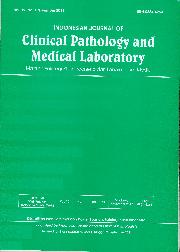Indonesian Journal of Clinical Pathology and Medical Laboratory
ISSN 0854-4263
Vol. 19 / No. 1 / Published : 2012-01
Related with : Scholar Yahoo! Bing
Original Article :
Aerob bacteria and antimicrobial susceptibility
Author :
- Erviani Zuhriah*1
- Nurhayana Sennang*2
- Darmawaty ER*3
- Bag PK FK-UNHAS Makassar
- Bag PK FK-UNHAS Makassar
- Bag PK FK-UNHAS Makassar
Abstract :
Nosocomial infection is an infection acquired in hospitals, which occur more frequently in poor and developing countries such as Indonesia, one percent of the related cases leads to death. The occurrence of nosocomial infection causes the lengthening of hospitalization and increased risk of disease transmission. According to Permenkes No. 1204/Menkes/SK/X/2004, the Emergency Room is one of the high-risk areas. The objectives of this research were to quantify the number of aerobic bacteria, to know the identification method of the pathogenic bacteria and to determine the antimicrobial sensitivity pattern in the emergency installation. A cross sectional study was performed by collecting air samples at eleven treatment rooms of the Emergency installation in dr. Wahidin Sudirohusodo Hospital Makassar by using Microbiology Air Sampler 100 (MAS 100). The bacterial identification and antimicrobial susceptibility tests (AST) were conducted at the Balai Besar Laboratorium Kesehatan Makassar (July to September 2009). The number of bacterial colonies were 288 - 6570 CFU/m3. Pathogenic bacteria identified in the study were Stomatococcus mucilaginous, Staphylococcus haemolyticus and Acinetobacter calcoaceticus, which were still sensitive to tetracycline and resistant to ceftazidim and kanamycin.The number of bacterial colonies exceeded the standard number established by the Decree of Indonesian Health Minister. Infeksi asal rumah sakit (nosokomial) merupakan infeksi yang diperoleh di Rumah Sakit, kejadian terbanyak di negara miskin dan berkembang seperti Indonesia, sejumlah 1% penyakit tersebut menyebabkan kematian. Infeksi nosokomial yang terjadi menyebabkan lama hari perawatan dan kebahayaan penularan penyakit meningkat. Berdasarkan Permenkes No. 1204/Menkes/SK/X/2004 Ruang Instalasi Rawat Darurat (IRD) termasuk kelompok berkebahayaan sangat tinggi. Tujuan penelitian ini adalah untuk menghitung jumlah koloni bakteri, mengenali cara dan menentukan pola kepekaan bakteri penyebab penyakit (patogen) di ruang Instalasi Rawat Darurat (IRD) RS. dr.Wahidin Sudirohusodo Makassar. Penelitian menggunakan metode potong silang menggunakan alat Microbiology Air Sampler 100TM dengan cara mengambil sample udara di sebelas Ruang Perawatan IRD. Perhitungan jumlah koloni bakteri, pengenalan bakteri patogen dan uji kepekaan dilakukan di Balai Besar Laboratorium Kesehatan Makassar (bulan Juli-September 2009). Jumlah koloni bakteri berkisar antara 288 – 6570 CFU/m3. Bakteri patogen yang ditemukan adalah Stomatococcus mucilaginous, Staphylococcus haemolyticus dan Acinetobacter calcoaceticus yang semuanya masih peka terhadap tetrasiklin dan resisten terhadap ceftazidim dan kanamisin. Berdasarkan hasil telitian ditemukan Jumlah koloni bakteri melebihi bakuan Permenkes.
Keyword :
Bacteria, aerobic, pathogen, antimicrobial susceptibility test, emergency installation,
References :
Darmadi,(2008) Perkembangan Penanganan Infeksi Nosokomial dalam Infeksi Nosokomial Problematika dan Pengendaliannya Jakarta : Salemba Medika
Utama HW,(2006) Infeksi Nosokomial Jakarta : www.klikharry.wordpress.com
Anonymous,(2009) Infeksi Nosokomial Jakarta : www.geocities.com
Guntur,H,(2007) The Role of Cefepime: Empirical Treatment in Critical Illness Jakarta : Dexa Media
Nasir US,(2009) Risiko Bahaya Potensial di Rumah Sakit Jakarta : www.ukkisafetynasier06.astalog.com
Archive Article
| Cover Media | Content |
|---|---|
 Volume : 19 / No. : 1 / Pub. : 2012-01 |
|












